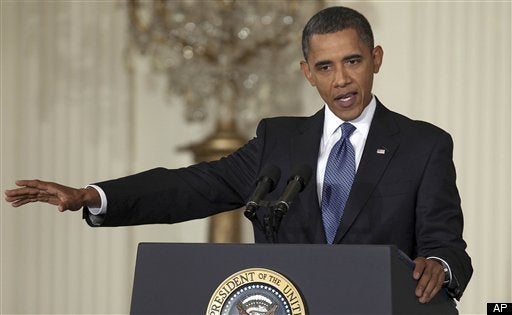
"If 2009 was about the data platform, Data.gov, I would argue that 2010 is about thinking through the participatory platforms," said Aneesh Chopra, the chief technology officer of the United States.
As is the case everywhere open government is in beta, the question of whether crowdsourcing national challenges at Challenge.gov leads to better solutions will remain outstanding for months time to come.
While Challenge.gov may be the most visible platform, the first US CTO is thinking big in terms of leveraging technology to meet the policy goals of the Obama Administration. "We've also have relaunched the Federal Register," said Chopra, "which I believe makes it a lot easier to digest the news of the government so that new ecosystems may emerge that will galvanize people to move on issues that maybe may not have been an area of focus for them." In a wide-ranging exclusive interview last week at the Gov 2.0 Summit, Chopra answered questions about the challenges of implementing open government, reaching an increasingly mobile citizenry, addressing the digital divide and more.
What does the federal CTO do?
Chopra, who is perhaps most familiar to the American people as the "Indian George Clooney" after Jon Stewart poked a bit of fun at the open government IT execs at the White House on the Daily Show, has an unusual place in American history.
In fact, it's unprecedented.
My publisher, Tim O'Reilly, made a case for why Aneesh Chopra is a great choice for federal CTO last April, when the news of his selection leaked from the White House. Tim put the role of a federal CTO in the context of someone who provides "visionary leadership, to help a company (or in this case, a government) explore the transformative potential of new technology."
Given the immense challenges that the United States faces at home and abroad in marshaling the generative resources of its people and industries, the timing for his appointment couldn't have been more apt. While Gawker tagged him for a "chummy confirmation hearing," he earned the public support of many luminaries in the tech industry, like Dan Bricklin and Mitch Kapor. After laughing about that Daily Show thing, Chopra has been moving forward with breaking a trail in the position.
His performance in the role has continued to enjoy positive reviews from prominent members of the tech community as well. "Open government, open data, national educational technology plan, smart grid, telehealth, open source," said J. P. Rangaswami, Chief Scientist at the BT Group. "Chopra is doing all the right things. The Challenge project is also the right direction. Only 'could-do-better' is the National Broadband plan. I think the US deserves more, faster."
The Center for Democracy and Technology also called CTO Chopra a "breath of fresh air" after his speech in Silicon Valley last year, although Jim Dempsey, writing in organization's blog, did critique "his repeated emphasis on accomplishing things without changing the underlying laws. On the one hand, working within existing frameworks is consistent with his attractive opportunism. However, it is clear that some laws need to be updated to ensure deep, government-wide change."
In November, the role of the federal CTO will extend that to digital diplomacy as he travels to India with Alec J. Ross, the State Department's innovation advisor, as part of another tech delegation.
When I asked Chopra about what he actually does as a CTO, Chopra pointed to several elements, focusing first on his role as a special assistant to the President, along with Summers, Browner or De Paul. "I make sure that the technology, data and innovation aspects of any given policy that comes before the president are thought through and are considered in a little more aggressive way," he said. "In a sense, I'm issue-spotting for the president."
He also talked about that conveners role, both internally and externally, defining the government's role in standards policy and "trying to get voices from across the federal government to have a consensus voice." Given the multitude of government workers, it's safe to say that could eat up some hours. (On a lighter note, Chopra also note that the CTO's role did not extend to providing the Presidential "ObamaBerry," though he does end up providing tech support in the occasional meeting.)
For more on this count, see Chopra's interviews with Marc Steiner about the role of the federal CTO this January or video with Sarah Granger last December.
Mobile apps and APIs
One area where the federal CTO has embraced the strategy prevalent in Silicon Valley is focusing on platform development, particularly in the mobile space. After all, the president's insistence on a smartphone is matched by the preferences of an increasingly mobile electorate, which feeds into the importance of providing applications or e-services to citizens wherever they are.
"The more we rely on APIs and app development, the more we're naturally seeing mobile applications come," said Chopra. "A) they're easier to develop and B) there's a whole ecosystem around making them simpler." He's also looking at other places where standards will matter.
"In the same spirit, we put recommendations in the technical standards framework that basically said federal agencies should provide Web services that would allow for their data to be accessible not only to state and local agencies that want to interface but also third party developers, whether they be in a mobile context or otherwise, who could then build out services on that infrastructure."
Chopra also cited the call by the President to nearly double the amount of spectrum available for mobile broadband or the FCC's "white spaces" plan. As Kim Hart reported it in Politico's Morning Tech, the FCC's position is that "unleashing white spaces is the first significant block of spectrum made available for unlicensed use in more than 20 years, and it will build on the success of Wi-Fi, Bluetooth, garage door openers and cordless phones - all that use unlicensed airwaves. See the FCC fact sheet for more information or the New York Times story on unlicensed spectrum for more.
On tech policy, Chopra said that they're "injecting" mobility into in key areas, like the $4 billion dollar White House Office and Science Technology R&D portfolio. He also said that after spectrum auctions, the first thing that's going to get financed is the development of a national public safety interoperable broadband network. "The goal is that by the end of the year we will have a coherent mobile broadband strategy for first responders," he said.
Addressing the digital divide
One of the challenges with a technology-fueled agenda is empowering more citizens to participate in the digital revolution. How is the federal government moving to address the issues presented by the digital divide? What is the strategy to include historically disconnected populations in the opportunities of open government and innovation afforded by Gov 2.0 initiatives online?
Chopra pointed to the FCC's National Broadband Plan first. "When they published their report, the President asked for guidance," he said. "Digital literacy is amongst the top priorities and is an important place to comment."
He also pointed to an important issue in the future: implementation work for the technology challenges that are mandated by the healthcare reform bill. Launching Healthcare.gov quickly was a responsibility of the CTO of HHS, Todd Park. Chopra looked ahead to how technology will be used as an extension of policy. The new law "called for standards for best customer experience for people that will be interfacing with insurance exchanges," said Chopra, noting the "45 million Americans who will be accessing public services for the first time."
Lessons learned from implementing open government
It comes as no shock to observers and practitioners alike that the implementation of open government is much harder than issuing initiatives and directives. Is the federal CTO learning from those challenges and iterating to speed up the feedback loop between policy and outcomes?
Chopra allowed that the "single biggest area where the variation is maybe not to the best" was in the data inventory of high data value sets at agencies. That said, he pointed to the Transportation Department's infrastructure for data validation and the importance of allowing agencies to innovate within broad requirements. "We never would have designed the Transportation infrastructure architecture program if we were forced to do it in a top-down way," he said. The question, as he chose to frame it, is "how do we create enough central goal setting, with enough freedom that would tap into creativity and entrepreneurial thinking at the agency level?"
While there are areas where innovation in open government hasn't lived up to expectations, one lesson Chopra pointed to was in identifying innovative ideas and then rapidly scaling them. That's true of innovation generally, he said, from having the idea to proof point, and then moving proof point to scale. "I think we have delivered on the former," he said. "The latter is where there will be a challenge going forward."
What apps have come out of open government data? Chopra highlighted the work of Park at HHS, where the agency is working on making community health information as useful as weather data. If the mission of the agony is to improve health of citizens, Chopra argued that it was greatly aided by convening technologists and government healthcare officials to feature the development of healthcare apps. They "didn't innovate on technical design of better machine readability or better parsing strategies," said Chopra. "It was the ecosystem development that was the innovation. "
Closing the IT gap
One of the most pressing issues for Chopra and his counterpart, federal CIO Vivek Kundra, is whether IT can be used to close the yawning gap in federal and state government budgets. Former OMB "director Peter Orszag's speech, "Closing the IT Gap," explains what we're about with Gov 2.0 Events," said Tim O'Reilly earlier this year. Orszag spoke at length at the Center for American Progress on a "significant IT gap" that has developed between the public and private sector. Orzag cited this IT gap as a big part of the productivity divide between the two.
So why does the IT gap persist? "It's because the DNA of our federal agencies, from procurement policy to how they go about issuing requirements, that whole process for acquisition, has largely rewarded the acquisition of yesterday's approach, as opposed to investing in the adoption of first proof points of the new approach," said Chopra.
"So, there's a more fundamental question about what's considered core IT development and what's considered the end product that adds value. what we're seeing is more IT development for back offices purposes accounting for a higher share of the overall IT spend than the mission-oriented development activity that has the ability to actually produce the policy objectives that are called for."
Chopra went on:
"I would argue that there' an acquisition challenge, there's been on oversight challenge, an accountability challenge. Vivek is all over all of that. To the extent that I have a particular voice and role in this conversation, it is how do we more closely align the R&D and the innovation ecosystem as first adoption points in government, as opposed to last adoption points."
Video of Tim speaking with Chopra and Kundra at the Gov 2.0 Summit about the various elements of this IT gap is below.
Untangling the issue will not be easy, but it's crucial if government IT is to improve. Wired's report that HP holds navy network 'hostage' for $3.3 billion highlights just one of the challenges. The move by OMB to cut and revise $337 million worth of IT contracts shows some seriousness on the side of the CIO to address failing projects.
Now, it remains to the nation's first CTO to connect the dynamism that has driven the information economy to making its government more efficient, effective and nimble.
